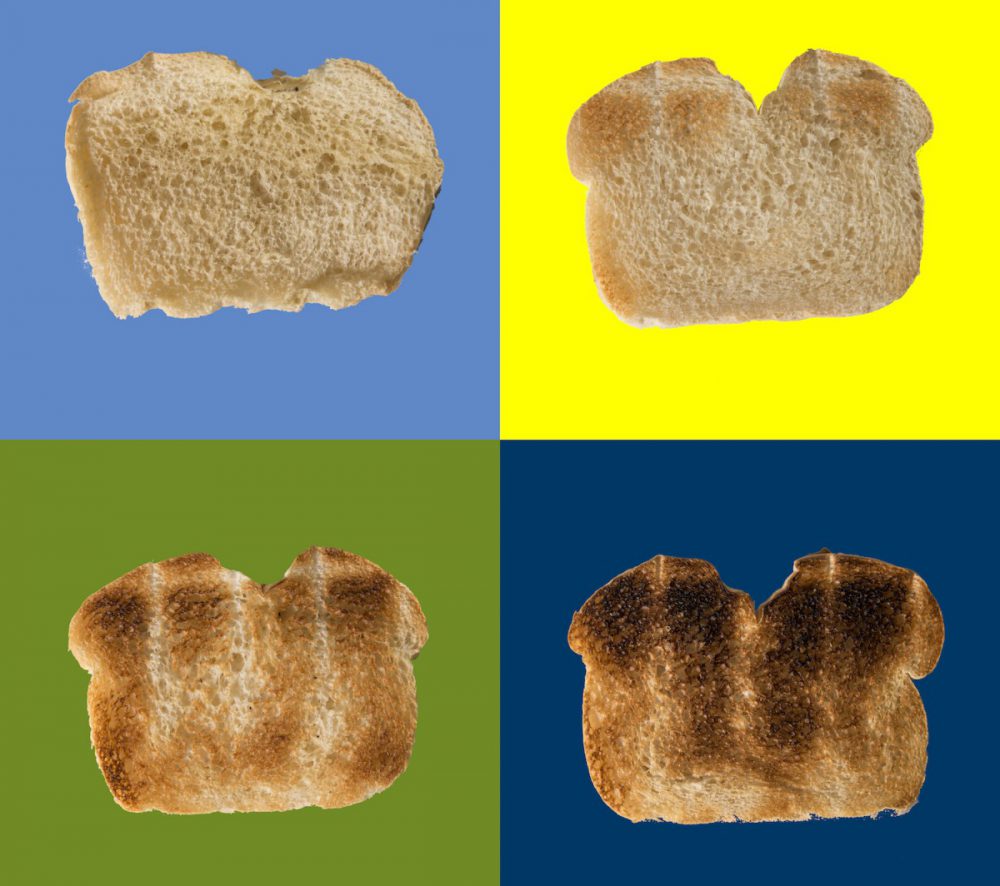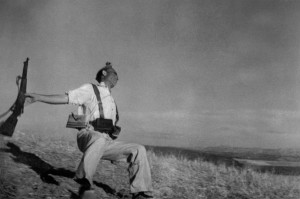I believe Capa’s photo of the fallen solider is not staged because it is possible for the solider to get shot while Capa takes a picture of him since he is out in the open while the other soldiers are hiding. At first, I thought this photo was staged because it doesn’t show where he got shot but after seeing a photo of his position in the war, I believe it is not staged. I find Whelan’s argument convincing because he also provided photos to prove his point. In my opinion, I don’t think authenticity matters because every photo is unique in its own way, doesn’t matter if it’s authentic or not.
Category Archives: Homework
Alison Yan, Homework #3 Robert Capa
Robert Capa’s photograph of a Falling Soldier raises questions to the authenticity of the photograph. The photograph of a falling solider looks staged to me, because a lot of elements in this picture look too perfect, or not detailed enough. The position when the solider fell does not appear to be a natural position, rather, it looks like he was in an ‘I’m ready to fall’ pose. If the solider is getting shot at during this exact moment, the view does not hint at where the bullet hit, nor is there a detailed information about the picture. There was talk about gathering soldiers to take a posed photograph. Because taking pictures in open fire is dangerous, it is the reason why war photography is a really hard field to tackle. I think Robert Capa’s works are very commendable, but whether or not his photographs are an accurate depiction of times of war. Also, whether or not his photographs represent a wartime masterpiece or they are staged war photographs, only he would know the truth.
It is hard to know if what we are shown is authentic or not. If we are not a primary witness, we don’t know what happened. It is the same as listening to an oral tale. The photographer is a primary witness, that we know, because the photographer is at the scene to take the pictures. So when seeing photographs, people tend to think it is real, that the event did happen without a doubt, as it is. But because things are captured by one person, the photographer, they can easily fabricate the event, and tamper with their own work. People would not know the truth unless they are told, or until they are proven right or wrong. Having a camera is a powerful weapon and tool to capture the truth. Now that I think back on the pictures, I realize that I question the authenticity of how much was the actual truth and how much was staged, like a photoshoot.
Homework #3 Robert Capa
I thought that was a staged picture when I first saw “Death of a Loyalist Soldier.” After I read Robert Whelan’ s discussion of Capa’ s photograph, I still think the photo is real. Whelan’ s argument in somehow is convincing. Here are few reasons which made me felt the photograph is staged, including the place information had never been mentioned, people were saying that the soldier who is in Capa’s photo also appears on another photography where published in a magazine, and the timing when Capa captured that soldier’s falling moment. If a soldier gets shot, the body will fall immediately and as soon as possible, so there will be no time left for a photographer to press the shutter. But as what Whelan said in his argument, Capa prepared himself for taking any upcoming photograph, so that is why he could capture this moment without the soldier totally falls down on the ground. There is why Capa had made the greatest war photographs.
Overall I don’t think the authenticity matter. No matter The “Death of a Loyalist Soldier” is staged or real, the intention of Capa taking this photograph has been well knowing to the public. People have a sense of what have happened and how these soldiers sacrifice in war through viewing this picture is enough already. It is unnecessary for arguing between the fakery and reality.
“The Falling Soldier”
The argument of Richard Whelan, where the soldiers were attacked because they called attention to hidden enemies, is pretty much acceptable. This based on the photo of the soldiers holding their rifles up and the data of not much going on in Cerro Muriano. However, because this was an area that was at war, we can accept the idea of hidden enemies waiting to attack.
In my opinion Capa’s photograph is not staged and Whelan proves this in many ways, like by proving that Capa was in Cerro Muriano by comparing photos by Namuth and Reisner to Capa’s photos where same people were shown in the three photographers’ photos. Another important proof of this is the hand of the falling soldier, that appears curled toward the palm. This makes me think that if the photo was staged this soldier’s hand would break at that moment because his body would fall on top of his hand. I do think that the authenticity of the photos of the falling soldier matters because it shows the world the face of war in a deep way, by showing how people fight and are prepared to lose their lives for their rights.
Falling Soldier
while doing research of biography of Robert Capa, Richard Whelan has expressed his mixed feelings about the famous photograph about the fallen soldier during 1936 Spanish civil war. The photograph of fallen soldier shot in head has arose wide issues about its authenticity. Most of the audience has believed it to be staged. I, myself understand this photo as a fake and staged too. There are no exact evidences traced about Robert Capa traveled to Spain and captured that snap right on the spot when the soldier was shot in head and fallen to the ground. The falling body’s gesture also expresses that the photograph was staged since it doesn’t seems dead body falling to the ground.
Homework #3 Robert Capa
As I read Whelan’s argument, overall I think the photograph “Falling Soldier” is not staged, but I think he was trying to set up a stage though. The argument was very convincing. I do not want to say the entire photograph faked, but I think Capa was trying to set up a stage at that moment, but unfortunately, the soldier got a bullet in his head right before he tried to do some pose. I think that was real and that moment was not a fake and staged. Since there is no any distinct evidence of the truth, we cannot have an argument that is staged or not. And since Capa is already gone and no one can really tell the truth, why do people hurting his reputation?
He was a great photographer, loved war photo, and tried to show people the truth of the war. As that facts, he deserves the reputation already and to be respectful.
In addition, I do think authenticity is important. Because of one photo, it can change the point of view and bring the people confusion and distortion of the truth.
I like to have an example of staged photograph, which is “Alexander Gardner, Home of a Rebel Sharpshooter, July 1863”. This Gardner’s photo is known as staged photo, and somehow I can sense Capa’s photograph seems similar. I think Capa was trying to do somewhat similar with this photograph.
Robert Capa Homework Jessica Abate
I thought Whelan’s argument overall was convincing about Robert Capa’s photo of the fallen soldier. I did not think his entire argument was convincing because some parts seemed like a stretch. He talked a lot about where Capa might have been when he took the photo and right before it, but that was all based on what other people said. There was no concrete visual evidence to prove what he was saying was true. His strongest point that was most convincing was talking about the positioning of the hand. That was visual evidence that scientifically makes sense and is not based on what someone else said or thinks.
I do not think this photo was staged. Based on what Whelan said about the placement of the hand and the look of the photo in general, I think Capa did take this photo as someone was dying. Also you can clearly see the mark in the man’s head. At that time, I do not think photographers had the ability to stage something that looks so realistic.
Regardless of what I think about the photo, I do think authenticity is important. Especially in this case it is important that photographers tell the truth about the photo. Capa’s entire career was based on this photo, if he lied his entire career was faked. He was most famous for taking the first photo of someone dying, so if that isn’t true he shouldn’t have deserved all the fame he got.
Homework #3: Robert Capa’s Death of a Loyalist Soldier
At the age of 23, Robert Capa took a photograph that many have labeled the greatest war photograph of all time. Taken during the Spanish Civil War, the renown of Capa’s photograph, Falling Soldier or Death of a Loyalist Soldier, reverberated around the world as it was published and republished in contemporary news magazines. However, Capa’s photo has been shadowed by controversy, including accusations of fakery. Read an analysis on the image by Capa’s biographer, Robert Whelan, on the authenticity of the photograph. Do you find his arguments convincing? Do you think Capa’s photograph is staged or not? And do you think its authenticity matters? If you wish, you can compare Capa’s photograph to another controversial image.
Richard Whelan’s discussion of Capa’s photograph
To complete this homework assignment, please submit a post.
Please post your responses by Monday, December 11th.
Culinary Arts I Homework
I had never thought that a normal deli store conversation can become a poem until I read the “Counterman” in the last class. The whole poem is surrounded by how a counterman takes care of the different sandwich orders from the customers in a rush hour. We read the poem three times in the class. The more we read about it, the more intense of the feeling I get form the counterman.
As I was reading this poem, I think of the New York City deli stores. Most of the New Yorkers have a very busy life, so they do things quicker than others. Whenever you go to a deli store or fast food restaurant in lunch hours, you will see the counterman takes order as fast as they can because they want to save more time for the next customers. Paul Violi was born in the New York City, so he definitely understands the same feeling, hence he wrote this poem. I also feel like it is an amazing story for telling the people about the food industry as art through a poem.
“Crazy About Her Shrimp” Poem Reaction
“Crazy About her Shrimp” by Charles Simic is a poem that describes the experiences of a couple in an evening. They are crazy in love. This couple are not only in love with each other but also, in love with food. The most amazing part is that they both share the same fascination for food. Simic, described all the fun they have in the kitchen and how much fun they have with each other while cooking. I really like this poem because I like to relate a good experience with food too, and a good experience with love. After reading this poem, when this couple is sharing the same passion for food, it makes the experiences of food greater.





